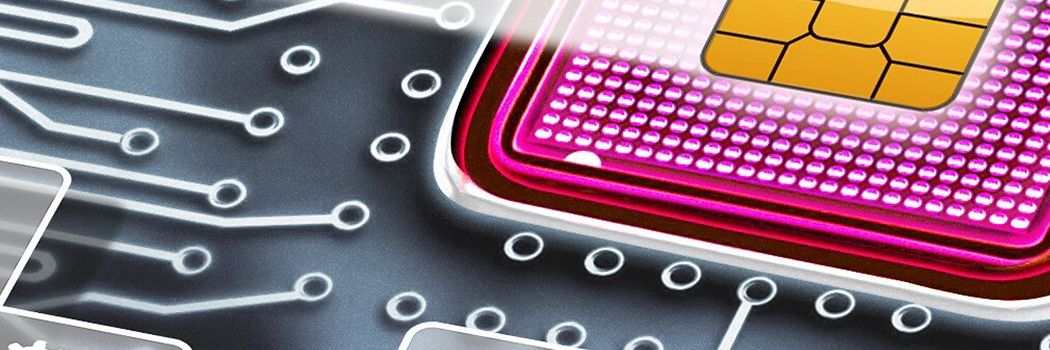
nuSIM
Die integrierte SIM für das Internet der Dinge
Die integrierte SIM für das Internet der Dinge
Die integrierte SIM für das Internet der Dinge
Die integrierte SIM für das Internet der Dinge
Sensoren im Behälter messen den Füllstand und benachrichtigen die Müllabfuhr, wenn eine Leerung ansteht.
Die Vorteile:

Smarte Sensoren melden, ob ein Parkplatz frei oder belegt ist.
Die Vorteile:

Robuste Tracker mit langer Batterielaufzeit verfolgen Waren in der gesamten Lieferkette.
Die Vorteile:
![]()
Für IoT Endgeräte sind Herstellungskosten, Energieeffizienz, Baugröße und die allgemeine Komplexität entlang der Wertschöpfungskette sehr wichtige Parameter. Auch die SIM, als unverzichtbarer Bestandteil des Endgerätes, hat Einfluss auf diese Faktoren, der sich optimieren lässt: Durch die integrierte nuSIM entfällt ein separates Bauteil, entsprechend optimieren sich Kosten, Energiebedarf, Design und Logistik. Für die Deutsche Telekom sind dies Erfolgsfaktoren im IoT-Markt.
Die M2M eSIM ist eine sehr komplexe Lösung und nicht wirklich für einen kostensensiblen Kontext geeignet. Im Übrigen schließen die technischen Einschränkungen des NB-IoT-Standards, wie die sehr begrenzte Übertragungsleistung, der Fokus auf batteriesparende Arbeitsweise sowie die nicht vorhandene SMS-Unterstützung den Einsatz der M2M eSIM aus.
eSIM (embedded SIM) und iSIM (integrated SIM) sind zwei verschiedene Lösungen. Die eSIM ist zwar fest mit dem Gerät verbunden und nicht austauschbar – also „eingebettet“ –, aber immer noch eine separate Komponente auf der Platine. Daher war es ein logischer Schritt für die Deutsche Telekom, die SIM direkt in den Baseband-Prozessor zu verlegen, also in den Chip, der für die Funk-Kommunikation zuständig ist. Damit entsteht eine iSIM, eine integrierte SIM. nuSIM ist also eine iSIM.
Die eSIM nach GSMA Standard verfügt über typische Spezialfunktionen, etwa zum Hinzufügen von mehreren Teilnehmerverhältnissen (sog. Profile) over-the-air sowie zu deren wahlweiser Aktivierung und Löschung. Damit ist die eSIM allerdings sehr komplex und nicht für IoT-Anwendungen geeignet, bei denen es auf Effizienz und Einfachheit ankommt (und wo diese Funktionen oft gar nicht gefragt sind). nuSIM reduziert die SIM auf das absolut Notwendige – alles, was nicht erforderlich ist, wurde konsequent weggelassen. Das führt zudem dazu, dass nuSIM-Profile sehr viel kleiner sind: Nur ca. 1 KByte anstelle von (typisch) 50 KBytes bei eSIM.
Ganz einfach: Es gibt noch keine standardisierte SIM-Lösung, die allen Anforderungen und Einschränkungen des stark wachsenden Low-Cost-IoT Segments genügt. Zudem sind Standardisierungs-Organisationen nicht unbedingt für unkomplizierte und schnelle Ergebnisse bekannt. Beides waren entscheidende Aspekte für uns, eine eigene Lösung auf den Markt zu bringen.
Die nuSIM ist für IoT optimiert und enthält daher nur SIM-Funktionen, die für diese Anwendung wesentlich sind. Im Zuge einer stringenten Verschlankung wurden etwa der Over-the-Air-Zugang, das SIM-Toolkit, die Unterstützung von Java Card Applets sowie nicht benötigte Teile des SIM-Dateisystems entfernt. Die Folge: Überschaubare Komplexität, geringer Speicherbedarf und sehr kleine Profile.
Eine weitere Besonderheit: nuSIM zielt von vornherein auf ein offenes und diverses Ökosystem, in dem die neue Technologie von möglichst vielen Partnern getragen wird, die mit ihren Produkten eigenständig am Markt agieren. Daraus entstehen Wettbewerb und die notwendige Wahlfreiheit für unsere Kunden.
Bereits die Chiphersteller können ihren Bauelementen mit der integrierten nuSIM einen klaren Mehrwert geben. Bei den Modulherstellern führt dies zu kleineren und energie-effizienteren Produkten und sie können direkt mit Mobilfunk-Netzbetreibern zusammenarbeiten, um bereits auf der Modul-Ebene das gewünschte SIM-Profil zu integrieren. Für die Gerätehersteller ergeben sich Designvorteile und es entfällt der gesamte Aufwand für Lagerung, Logistik und Handhabung separater SIM-Karten. Und der Endkunde profitiert, wenn neue Geräte „out-of-the-box“ funktionieren.
Die Total Costs of Ownership (TCO) für klassische SIM liegt üblicherweise bei etwa einem US-Dollar pro Stück. Das umfasst die SIM, die damit verbundene Logistik und die Handhabung während der Produktion. Die TCO steigen deutlich, wenn die eSIM ins Spiel kommt. Nicht so bei der nuSIM: Abhängig von Skalierungseffekten erwarten wir deutlich geringere Gesamtkosten, weil die integrierte SIM-Funktion solche Kostenanteile gar nicht hat und weitere Einsparungen, etwa durch den entfallenden SIM-Karten-Halter. Die Zielkosten für ein NB-IoT-Modul liegen heute bereits unter der Schwelle von fünf US-Dollar – mit fallender Tendenz. Der Bedarf für Einsparungen ist also erheblich.
Die nuSIM wurde 2019 mit 12 Partnern angekündigt, ein Jahr später ist diese Zahl auf 22 gestiegen – und es ist kein Ende in Sicht. Weitere interessierte Unternehmen sind jederzeit herzlich willkommen.
Alle Netzbetreiber innerhalb der Deutschen Telekom bieten künftig die nuSIM an. Darüber hinaus erhielten wir nach der Vorstellung des nuSIM Konzeptes viele Anfragen von Netzbetreibern aus der ganzen Welt. Auch unsere geschätzten Wettbewerber sind herzlich willkommen. Setzen Sie sich gerne mit uns in Verbindung oder sprechen mit den nuSIM Partnerfirmen. Diesen steht es frei, die nuSIM ohne Umweg über die Deutsche Telekom zu vermarkten.
Eine Reihe von verbindlichen Spezifikationen beschreibt die Funktion der nuSIM, die Schnittstellen für das Laden der Profile und die kryptografischen Sicherheitsprozesse. Dies schafft die Grundlage dafür, dass jedes nuSIM-Profil von jedem nuSIM Data Preparator auf jeden nuSIM-Chip geladen werden kann. Die Einhaltung der Spezifikationen wird natürlich überprüft. Dafür hat der nuSIM Partner COMPRION, ein etablierter Anbieter von SIM- und eSIM-Testsystemen, eine umfangreiche Testsuite entwickelt.
Ganz klar der Low-Cost-IoT Bereich. Es werden immer günstigere, kleinere und stromsparendere Geräte auf den Markt kommen, für eine Vielzahl von Anwendungen bei denen Endnutzer nicht selbst ihren Netzbetreiber wählen und die Services einfach „out-of-the-box“ funktionieren.
Alle unsere Partner arbeiten daran, die nuSIM in ihren Produkt-Roadmaps umzusetzen. Die nuSIM Infrastruktur steht bereit und aktuell befinden sich bereits mehrere Chip Prototypen in der Sicherheitszertifizierung. Die ersten nuSIM-Chips und -Module kommen in Kürze auf den Markt.
Prinzipiell ist die nuSIM mit jeder Mobilfunktechnologie kompatibel. Doch viele Vorteile der nuSIM beruhen auf ihrer reduzierten Funktion, so dass wir die Anwendung klar bei NB-IoT und LTE-M sehen, sowie in Multi-Mode Kombinationen mit 2G. Es wird jedoch spannend sein, wie sich nuSIM weiterentwickelt.
Wie bei der eSIM werden die Betreiberdaten als kleine, verschlüsselte Datei – dem sog. Profil – bereitgestellt und auf den Chip geladen. Bei der nuSIM wird das jedoch bereits zum Zeitpunkt der Modul- oder Geräteherstellung erledigt. Danach ist das Gerät sofort einsatzbereit.
Mit der nuSIM Loader Application beziehen Modul- und Gerätehersteller nuSIM-Profile in für Massenproduktion erforderlichen Mengen und verwalten diese bis zum Ladevorgang. Dazu fordert die Loader Application die Profile vom Data Preparator an, der sie im Auftrag eines Mobilfunkbetreibers zuvor erstellt hat. Der Data Preparator verschlüsselt nun die Profile und übergibt sie der Loader Application, wo sie gespeichert und dann zu einem unabhängigen Zeitpunkt auf die Chips geladen werden. Erst dort werden die Profile entschlüsselt und installiert. Der gesamte Bereitstellungsprozess ist durch moderne kryptographische Verfahren durchgängig gesichert, ähnlich wie beim Download von eSIM-Profilen.
Der Partner, der das Profil lädt – in der Regel der Modul- oder Gerätehersteller – muss die nuSIM Loader Application in seine Produktionsumgebung integrieren und betreiben. Dafür stellt die Deutsche Telekom eine quelloffene Referenzversion kostenlos zur Verfügung. Interessenten können dieses Tool unter eigener Marke nach Bedarf weiterentwickeln und vermarkten.
Ähnlich wie ein eSIM-SMDP(+) erstellt der Data Preparator im Auftrag eines Netzbetreibers die nuSIM-Profile für einen bestimmten Kunden (Modul- oder Gerätehersteller) und speichert sie, bis die passende Anfrage von der Loader Application des Kunden eintrifft. Dann überträgt er die Profile gesammelt und individuell verschlüsselt an die Loader Application, wo sie zur weiteren Verwendung gespeichert werden.
Jeder eSIM-SMDP(+) Betreiber kann relativ einfach Data Preparator für die nuSIM werden, denn die Prozesse zur Profilerzeugung und -bereitstellung sind an die der GSMA eSIM angelehnt. Interessierte Firmen können sich dazu gerne an uns wenden.
Ja, die nuSIM kann in jeder Lebensphase ein Profil erhalten. Wenn bereits ein Profil geladen ist, ersetzt das neue Profil einfach das bestehende. Dies ist auch im laufenden Einsatz möglich, etwa als Bestandteil von Firmware-Updates (FOTA) oder über Mobile-Device-Management (MDM), z.B. mittels des OMA Lightweight M2M (LwM2M) Standards. OMA SpecWorks hat dazu zwei nuSIM-Objekte standardisiert, welche die nuSIM und die nuSIM-Profile als Datenelemente abbilden, die von einem LwM2M Server verwaltet werden können. Ein Profilwechsel im Feld wird damit eine Aufgabe des Device Managements, unter Beibehaltung aller notwendigen Sicherheitsaspekte. Die Realisierung dieser optionalen Funktion erfolgt zusammen mit den Modul- und Geräteherstellern.
Jede nuSIM Implementierung wird unabhängig getestet und vom TÜViT zertifiziert. Die Bereitstellung der Profile erfolgt mit Ende-zu-Ende Verschlüsselung und durch GSMA-SAS-akkreditierte Data Preparator Partner.
„Nu“ ist eine alternative Schreibweise für das englische „new“, also „neu“. Das Urban Dictionary gibt zudem die folgende Definition: "Nu bezeichnet in seiner spezielleren Bedeutung die Neuauffassung einer bestimmten Kunst.“